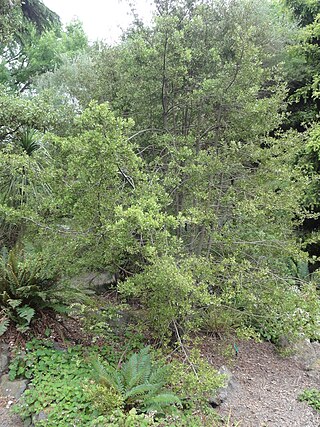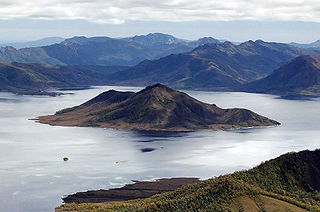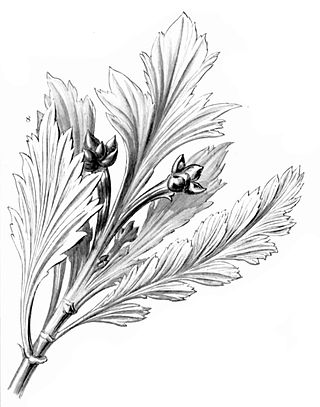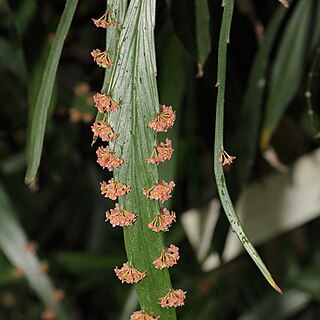
Podocarpaceae is a large family of mainly Southern Hemisphere conifers, known in English as podocarps, comprising about 156 species of evergreen trees and shrubs. It contains 19 genera if Phyllocladus is included and Manoao and Sundacarpus are recognized.

Phyllocladus, the celery pines, is a small genus of conifers, now usually treated in the family Podocarpaceae.Species occur mainly in New Zealand, Tasmania, and Malesia in the Southern Hemisphere, though P. hypophyllus ranges into the Philippines, a short way north of the equator.

The Tasmanian temperate rain forests are a temperate broadleaf and mixed forests ecoregion in western Tasmania. The ecoregion is part of the Australasian realm, which includes Tasmania and Australia, New Zealand, New Guinea, New Caledonia, and adjacent islands.

North Cape is the northernmost point of New Zealand's main islands. At the northeastern tip of the Aupouri Peninsula, the cape lies 30 kilometres (19 mi) east and three kilometres (1.9 mi) north of Cape Reinga. The name North Cape is sometimes used to refer just to the cape that is known in Māori as Otou and which overlooks Murimotu Island, and sometimes just to the eastern point of Murimotu Island. It is also used to refer to the whole larger headland stretching about five kilometres from Murimotu Island westwards to Kerr Point and including the Surville Cliffs. Statistics New Zealand uses a statistical area called North Cape for population data, extending south down the Aupouri Peninsula to the Houhora Heads.

The Styx Valley is a valley located adjacent to the Tasmanian Wilderness World Heritage Site on the island of Tasmania, Australia. The Styx River is the main drainage system of the valley that lies about 100 kilometres (62 mi) northwest of Hobart, with the nearest town being Maydena.

Phyllocladus aspleniifolius, commonly known as the celerytop pine, is an endemic gymnosperm of Tasmania, Australia. It is widespread and common in Tasmania, with the most abundance in the western highlands. Its ‘leaves’ appear similar to those of a celery plant, hence the common name.

Phyllocladus trichomanoides, the tānekaha or celery pine, is a coniferous tree endemic to New Zealand.

Phylloclades and cladodes are flattened, photosynthetic shoots, which are usually considered to be modified branches. The two terms are used either differently or interchangeably by different authors. Phyllocladus, a genus of conifer, is named after these structures. Phylloclades/cladodes have been identified in fossils dating from as early as the Permian.

Phyllocladus hypophyllus is a species of conifer in the family Podocarpaceae. It is found in Brunei, Indonesia, Malaysia, Philippines, and Papua New Guinea.

Phyllocladus toatoa, known as toatoa (Māori) or blue celery pine is a species of conifer in the family Podocarpaceae, endemic to New Zealand. It was formerly referred to as P. glaucus.
Podocarpus borneensis is a species of conifer in the family Podocarpaceae. It native to the island of Borneo, which is divided between Indonesia and Malaysia.

Phyllocladus alpinus, the mountain toatoa or mountain celery pine, is a species of conifer in the family Podocarpaceae. It is found only in New Zealand. The form of this plant ranges from a shrub to a small tree of up to seven metres in height. This species is found in both the North and South Islands. An example occurrence of P. alpinus is within the understory of beech/podocarp forests in the north part of South Island, New Zealand.

Pseudocoremia fenerata is a moth of the family Geometridae. It is endemic to New Zealand.
Coccomyces clavatus is a species of foliicolous fungus found on fallen phylloclades of Phyllocladus alpinus in New Zealand.
The Cromwell Mountains is a mountain range on the Huon Peninsula in north-eastern Papua New Guinea.

Catamacta alopecana is a species of moth of the family Tortricidae. It is found in New Zealand.

Chrysorthenches phyllocladi is a species of moth in the family Plutellidae. It was first described by John S. Dugdale in 1996. It is endemic to New Zealand and has been observed in both the North and South Islands. The larvae of this species feed on Phyllocladus alpinus. Adults have been observed on the wing in February, April and November.














